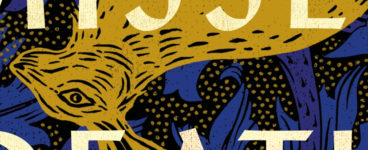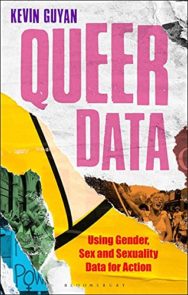‘Queer data is a powerful weapon; in the right hands, it can reshape all of our futures.’
Data has never mattered more. Our lives are increasingly shaped by it and how it is defined, collected and used. So it’s a great idea to get a clearer picture on how it is collected, analysed and applied, particularly in a world where it is as easy as it’s ever been to share false information. Kevin Guyan’s Queer Data: Using Gender, Sex and Sexuality Data for Action is a brilliant study on how this is done within the LGBTQ community, and is enlightening reading. Here we share an extract from the book’s introduction.
Extract taken from Queer Data: Using Gender, Sex and Sexuality Data for Action
By Kevin Guyan
Published by Bloomsbury Academic
Queer data is a tension. On one hand, it freezes in time and space particular ideas about what it means to identify as lesbian, gay, bisexual, trans and/or queer. It establishes these meanings as categories, which are fed into counting machines and used as the basis for decision-making. This construction and deployment of categories are at odds with the queering of data, which critically questions the foundations upon which these categories stand, the value granted to some identities above others and who actually benefits from the collection, analysis and use of data about LGBTQ people. Queer data is more than a study of individuals that sit outside the categories of heterosexual or cisgender. It is equally a brash, confrontational and in-your-face challenge to conventional understandings of how data and identities intersect – how people respond to queer data is either their problem or their wake-up call. As an approach to data and identities, queer data disrupts the binaries of male/female, heterosexual/homosexual and cis/trans and asks us to reconsider the notion that ‘numbers speak for themselves’. When data captures the lives and experiences of LGBTQ people, numbers do not speak for themselves – they always speak for someone. As I will argue, decisions made about who to count, what to count and how to count are not value-neutral but bring to life a particular vision of the social world. (1) Queer data exposes the decisions made about data, from collection to its use for action, to ensure that data about LGBTQ people is used to construct a social world that values and improves the lives of LGBTQ people.
Gender, sex and sexuality data is having a particular moment in the UK with increased interest from those outside of academic contexts and those engaged in data practices in the public, private and voluntary sectors. (2) Some of this interest relates to the UK’s 2021 and 2022 censuses, which, for the first time, capture data about the population’s sexual orientation, gender identity (England and Wales) and trans status/history (Scotland), discussed in Chapter 3. The addition of these questions marks a landmark moment for LGBTQ representation and the potential for improved evidence to address inequality. Yet, participation in the census, and other data collection exercises, is a double-edged sword as they require LGBTQ people to engage in practices that flattens the diversity of experiences and design-out certain lives. This data dilemma, the potential benefits of being counted versus the risk of being counted in ways that are inaccurate or further entrench inequality, might seem relatively new. However, there exists a long history of political and social struggles over the design of classification systems that present themselves as ‘purely technical’ but promote a biased account of the social world. (3) Several studies have investigated the implications of this data dilemma for women, indigenous communities and people of colour. (4) María Lugones has described how mechanisms of ‘heterosexuality, capitalism, and racial classifications’ were forged by colonial powers as a ‘colonial/modern gender system’ that has since shaped contemporary ideas about identity classifications. (5) Lauren E. Bridges has also explained that histories of naming and categorization ‘have long been entangled in histories of sovereignty, colonialism, subjugation and exploitation’. (6) Critical race theorists, such as Richard Delgado and Jean Stefancic, have similarly argued that races operate as ‘categories that society invents, manipulates, or retires when convenient’. (7) Although ‘invented’ as a category, the effects of race on social relations and people’s life opportunities are material and multiple. (8) Queer Data expands on feminist, postcolonial and critical race scholarship to explore how, among LGBTQ individuals, those who stand to benefit from ‘being counted’ also risk engaging with technologies that might normalize categories and practices that hamper rather than help the wider LGBTQ population.
The topic of difference has energized the work of LGBTQ researchers, practitioners and activists since, at least, the middle decades of the twentieth century. Although this work addressed themes such as social mobilization, political organization and cultural representation, the experiences of people we might now describe as LGBTQ have historically eluded data collectors and analysts, an absence I explore in Chapter 1. (9) In rare instances where data about individuals that transgressed normative ideas about gender, sex or sexuality was captured in datasets, it predominantly featured as a means to pathologize or stigmatize, record acts understood as criminal or deviant, or differentiate individuals from the normative majority. Knowing more about the membership and contours of an identity group can inform decisions made about the allocation of resources, changes in legislation, access to services and protections under the law. Gathering evidence of a problem is one of the key methods used to advance the rights of marginalized groups in the UK. For example, public bodies are required to publish relevant and proportionate information that demonstrates their compliance with the duties described in the 2010 Equality Act. (10) This includes the collection, analysis and publication of employees and service users’ data, as it relates to nine protected characteristics: age, disability, gender reassignment (trans status), marriage and civil partnership, pregnancy and maternity, race, religion and belief, sex and sexual orientation. Heightened data competence can therefore ensure data is used to improve the lives and experiences of LGBTQ people rather than only serve the interests of, what Catherine D’Ignazio and Lauren F. Klein describe as, the three S’s: science (universities), surveillance (governments) and selling (corporations). (11) As a contested and political practice, the collection, analysis and presentation of data about LGBTQ people are partly constructed through administrative decisions made at each stage of this journey, as I discuss in Chapter 2. The production of meaning and subsequent distribution of life chances have the effect of reflecting an incomplete account of LGBTQ lives and experiences to the outside world and among LGBTQ people, whose sense of self is informed by this partial reflection. To minimize the risk of mistakes being made, LGBTQ people need to lead this work and seize control of data that impacts their lives, rather than trust that others will understand, or care enough to understand, experiences that sit beyond their personal frames of reference.
For this reason, Queer Data is unapologetic in its focus on the use of data for action that improves the lives of people about whom the data relates. With a focus on events in the UK, Queer Data offers an accessible introduction to the interplay between queer theory and gender, sex and sexuality data. (12) Peppered with examples from my work as an equality, diversity and inclusion researcher in Scotland and engagement in the design process of recent UK censuses, Queer Data encourages researchers, practitioners and activists to think about data differently and ask critical questions such as ‘Why do we collect data this way?’, ‘Whose interests does data serve?’ and ‘Why do we collect data at all?’ Queer Data charts a practical path through this tension that acknowledges data’s potential to recreate simplified, stereotypical and exclusionary rules but also operates as a tool to gather evidence, document inequality and bring about change. The conflictual ingredients of queer data therefore require researchers to adopt a mixed approach that elevates the stories of LGBTQ people but also exposes the constructed structures upon which all minority and majority identity characteristics stand. By demonstrating that data about cis and heterosexual people also has a history – shaped by social, cultural, economic and political factors – queer data ensures that LGBTQ people are not further marginalized or defined as the ‘other’ by the research tools used to investigate their lives and experiences. (13)
*
We stand at a key moment in history. New technologies and approaches, from big data to data abolition, overlap with longer-term disagreements over how to recognize difference among identity groups, the representation of difference through data and its use as an evidence base for action. Failure to engage with agencies that collect, analyse and use data potentially locks out LGBTQ communities from recognition and access to vital funding and resources. Yet, participation in these practices requires submission to normative approaches to categorization that involve the inclusion and exclusion of particular lives and experiences.
This work cannot take place with LGBTQ people looking in from the outside. Data is more than numbers in a database – it also presents a method for individuals to join together and shout ‘Look here, we exist!’ However, at the heart of these developments lies a tension between ‘being counted’ and ‘being beyond counting’, which exposes the strained relationship between queer theory’s disavowal of categories and the requirements of data to classify, arrange and make judgements based on these results. There is no simple solution to the push and pull that exists between understanding identity characteristics as something disparate and fluid versus something that you can tick on a diversity monitoring form. Queer Data navigates a path through this challenge that uplifts LGBTQ stories but also destabilizes the normalcy of data about cis, heterosexual people. How we think about data, a product of historical and cultural traditions, has blinkered us to how gender, sex and sexuality data can and should impact LGBTQ lives in positive ways. For those already engaged in data practices, Queer Data showcases ways to embed critical approaches in your work. For those new to these themes, I hope the following chapters demonstrate the diversity of initiatives underway, offer entry points to expand your queer data competence and embolden you to use data to challenge injustice. Queer data is a powerful weapon; in the right hands, it can reshape all of our futures.
*
1 I use the term ‘social world’ to underscore that perceptions of reality are contested, contextual and shaped by our actions rather than something objective that exists beyond us.
2 A constellation of activities related to gender, sex and sexuality data occurred between 2019 and 2021, including the Scottish Government’s formation of a Sex and Gender in Data Working Group, proposals to reform the Gender Recognition Act in the Scottish and UK Parliaments, and debate about approaches to the collection of diversity monitoring data in public, private and voluntary sector organizations.
3 Geoffrey C. Bowker and Susan Leigh Star, Sorting Things Out: Classification and Its Consequences (Cambridge: The MIT Press, 1999), 196.
4 Scholarship includes Catherine D’Ignazio and Lauren F. Klein, Data Feminism (Cambridge: The MIT Press, 2020); Maggie Walter and Chris Andersen, Indigenous Statistics: A Quantitative Research Methodology (Walnut Creek: Routledge, 2013); Ruha Benjamin, Race after Technology: Abolitionist Tools for the New Jim Code (Medford: Polity, 2019).
5 María Lugones, ‘Heterosexualism and the Colonial/Modern Gender System’, Hypatia 22, no. 1 (2007): 187.
6 Lauren E. Bridges, ‘Digital Failure: Unbecoming the “Good” Data Subject through Entropic, Fugitive, and Queer Data’, Big Data & Society 8, no. 1 (1 January 2021): 2.
7 Richard Delgado and Jean Stefancic, Critical Race Theory: An Introduction (London: New York University Press, 2001), 7.
8 Zeus Leonardo, ‘Through the Multicultural Glass: Althusser, Ideology and Race Relations in Post-Civil Rights America’, Policy Futures in Education 3, no. 4 (1 December 2005): 409.
9 John Grundy and Miriam Smith, ‘Activist Knowledges in Queer Politics’, Economy and Society 36, no. 2 (May 2007): 301.
10 The Equality Act has three general duties: eliminate unlawful discrimination, harassment and victimization; advance equality of opportunity between people who share a protected characteristic and those who do not; foster good relations between people who share a protected characteristic and those who do not, noted in Equality and Human Rights Commission, ‘Public Sector Equality Duty’, 26 March 2021.
11 D’Ignazio and Klein, Data Feminism.
12 Recent studies that have also explored the intersection of queer theory and gender, sex and sexuality data include Kath Browne and Catherine J. Nash, eds., Queer Methods and Methodologies: Intersecting Queer Theories and Social Science Research (Farnham: Ashgate, 2010); D’Lane Compton, Tey Meadow, and Kristen Schilt, eds., Other, Please Specify: Queer Methods in Sociology (University of California Press, 2018); Amin Ghaziani and Matt Brim, eds., Imagining Queer Methods (New York: New York University Press, 2019).
13 For discussion of queer theory’s disruption of the centre and the margins, see Arlene Stein and Ken Plummer, ‘“I Can’t Even Think Straight” “Queer” Theory and the Missing Sexual Revolution in Sociology’, Sociological Theory 12, no. 2 (1994): 178.
Queer Data: Using Gender, Sex and Sexuality Data for Action by Kevin Guyan is published by Bloomsbury Academic, priced £17.99.
ALSO IN THIS ISSUE

 The Sky Beneath the Stone
The Sky Beneath the Stone
‘The Sky Beneath the Stone is the immersive and beautifully written first novel from bold new voice …

 Creative Response – Mrs Death Misses Death
Creative Response – Mrs Death Misses Death
‘I want to feel the benefits of time, to reap the rewards of growing older and reflecting, and to de …













